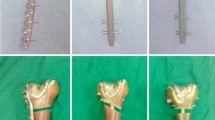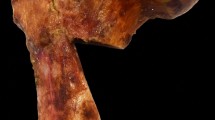Abstract
Introduction
Compromised bone quality and the need for early mobilization still lead to high rates of implant failure in geriatric patients with distal femoral fractures. With the newest generation of polyaxial locking plates and the proven retrograde femoral nails today two minimally invasive surgical procedures have been established. Indications for both procedures overlap. This study attempts to define the strength and failure mode of both surgical procedures.
Materials and methods
A standardized fracture model was established to simulate an unstable AO/OTA 33-A3 fracture. Eight pairs of human cadaver femora (mean age 79 years, range 63–100 years) with compromised bone quality were used. Osteosyntheses with eight retrograde femoral nails and eight locking plates were randomly performed. A materials testing machine (Instron 5566) was used to perform cyclic stress tests according to a standardized loading protocol, up to a maximum load of 5,000 N.
Results
All specimens survived loading of at least 2,500 N. Three nail and one plate construct survived a maximum load of 5,000 N. The mean compressive force leading to failure was 4,400 N (CI 4,122–4,678 N) for nail osteosynthesis and 4,429 N (CI 3,653–5,204 N) for plate osteosynthesis (p = 0.943). Proximal cutting out of the osteosynthesis was the most common reason for interruption in the nail and plate osteosyntheses. Significant differences between the retrograde femoral nail and plate osteosyntheses were seen under testing conditions for plastic deformation and stiffness of the constructs (p = 0.002 and p = 0.001, respectively).
Conclusion
Based on our results, no statements regarding the superiority of either of the devices can be made. Even though the load to failure values for both osteosyntheses were much higher than the loads experienced during normal walking; however, because only axial loading was applied, it remains unclear whether both osteosyntheses meet the estimated requirements for postoperative full weight-bearing for an average heavy patient with a distal femoral fracture.








Similar content being viewed by others
References
Aldrian S, Schuster R, Haas N, Erhart J, Strickner M, Blutsch B, Wernhart S, Leitgeb J, Platzer P (2013) Fixation of supracondylar femoral fractures following total knee arthroplasty: is there any difference comparing angular stable plate fixation versus rigid interlocking nail fixation? Arch Orthop Trauma Surg 133:921–927
Bergmann G, Deuretzbacher G, Heller M, Graichen F, Rohlmann A, Strauss J, Duda GN (2001) Hip contact forces and gait patterns from routine activities. J Biomech 34:859–871
Bottlang M, Doornink J, Fitzpatrick DC, Madey SM (2009) Far cortical locking can reduce stiffness of locked plating constructs while retaining construct strength. J Bone Joint Surg Am 91:1985–1994
Cristofolini L, Viceconti M, Cappello A, Toni A (1996) Mechanical validation of whole bone composite femur models. J Biomech 29:525–535
Duan X, Li T, Mohammed AQ, Xiang Z (2011) Reamed intramedullary nailing versus unreamed intramedullary nailing for shaft fracture of femur: a systematic literature review. Arch Orthop Trauma Surg 131:1445–1452
Döbele S, Horn C, Eichhorn S, Buchholtz A, Lenich A, Burgkart R, Nüssler AK, Lucke M, Andermatt D, Koch R, Stöckle U (2010) The dynamic locking screw (DLS) can increase interfragmentary motion on the near cortex of locked plating constructs by reducing the axial stiffness. Langenbecks Arch Surg 395:421–428
Egol KA, Kubiak EN, Fulkerson E, Kummer FJ, Koval KJ (2004) Biomechanics of locked plates and screws. J Orthop Trauma 18:488–493
Fankhauser F, Gruber G, Schippinger G, Boldin C, Hofer HP, Grechenig W, Szyszkowitz R (2004) Minimal-invasive treatment of distal femoral fractures with the LISS (Less Invasive Stabilization System): a prospective study of 30 fractures with a follow up of 20 months. Acta Orthop Scand 75:56–60
Fensky F, Nüchtern JV, Kolb JP, Huber S, Rupprecht M, Jauch SY, Sellenschloh K, Püschel K, Morlock MM, Rueger JM, Lehmann W (2013) Cement augmentation of the proximal femoral nail antirotation for the treatment of osteoporotic pertrochanteric fractures—a biomechanical cadaver study. Injury 44:802–807
Firoozbakhsh K, Behzadi K, DeCoster TA, Moneim MS, Naraghi FF (1995) Mechanics of retrograde nail versus plate fixation for supracondylar femur fractures. J Orthop Trauma 9:152–157
Greiwe RM, Archdeacon MT (2007) Locking plate technology: current concepts. J Knee Surg 20:50–55
Gwathmey FW, Jones-Quaidoo SM, Kahler D, Hurwitz S, Cui Q (2010) Distal femoral fractures: current concepts. J Am Acad Orthop Surg 18:597–607
Hartin NL, Harris I, Hazratwala K (2006) Retrograde nailing versus fixed-angle blade plating for supracondylar femoral fractures: a randomized controlled trial. ANZ J Surg 76:290–294
Heiney JP, Barnett MD, Vrabec GA, Schoenfeld AJ, Baji A, Njus GO (2009) Distal femoral fixation: a biomechanical comparison of trigen retrograde intramedullary (i.m.) nail, dynamic condylar screw (DCS), and locking compression plate (LCP) condylar plate. J Trauma 66:443–449
Hente R, Füchtmeier B, Schlegel U, Ernstberger A, Perren SM (2004) The influence of cyclic compression and distraction on the healing of experimental tibial fractures. J Orthop Res 22:709–715
Hwang JH, Oh JK, Oh CW, Yoon YC, Choi HW (2012) Mismatch of anatomically pre-shaped locking plate on Asian femurs could lead to malalignment in the minimally invasive plating of distal femoral fractures: a cadaveric study. Arch Orthop Trauma Surg 132:51–56
Hüfner T, Citak M, Suero EM, Miller B, Kendoff D, Krettek C (2011) Femoral malrotation after unreamed intramedullary nailing: an evaluation of influencing operative factors. J Orthop Trauma 25:224–227
Kenwright J, Goodship AE (1989) Controlled mechanical stimulation in the treatment of tibial fractures. Clin Orthop Relat Res 241:36–47
Kreb DL, Blokhuis TJ, van Wessem KJ, Bemelman M, Lansink KW, Leenen LP (2013) Intramedullary nailing without interlocking screws for femoral and tibial shaft fractures. Arch Orthop Trauma Surg 133:1109–1113
Kregor PJ, Stannard JA, Zlowodzki M, Cole PA (2004) Treatment of distal femur fractures using the less invasive stabilization system: surgical experience and early clinical results in 103 fractures. J Orthop Trauma 18:509–520
Leggon RE, Feldmann DD (2001) Retrograde femoral nailing: a focus on the knee. Am J Knee Surg 14:109–118
Link BC, Babst R (2012) Current concepts in fractures of the distal femur. Acta Chir Orthop Traumatol Cech 79:11–20
Meyer RW, Plaxton NA, Postak PD, Gilmore A, Froimson MI, Greenwald AS (2000) Mechanical comparison of a distal femoral side plate and a retrograde intramedullary nail. J Orthop Trauma 14:398–404
Miclau T, Holmes W, Martin RE, Krettek C, Schandelmaier P (1998) Plate osteosynthesis of the distal femur: surgical techniques and results. J South Orthop Assoc 7:161–170
Moed BR, Watson JT (1995) Retrograde intramedullary nailing, without reaming, of fractures of the femoral shaft in multiply injured patients. J Bone Joint Surg Am 77:1520–1527
Neubauer T, Krawany M, Leitner L, Karlbauer A, Wagner M, Plecko M (2012) Retrograde femoral nailing in elderly patients: outcome and functional results. Orthopedics 35:e855–e861
Ng AC, Drake MT, Clarke BL, Sems SA, Atkinson EJ, Achenbach SJ, Melton LJ (2012) Trends in subtrochanteric, diaphyseal, and distal femur fractures, 1984–2007. Osteoporos Int 23:1721–1726
Niedhart C, Braun K, Graf Stenbock-Fermor N, Bours F, Schneider P, Zilkens KW, Niethard FU (2003) The value of peripheral quantitative computed tomography (pQCT) in the diagnosis of osteoporosis. Z Orthop Ihre Grenzgeb 141:135–142
Perren SM (2002) Evolution of the internal fixation of long bone fractures. The scientific basis of biological internal fixation: choosing a new balance between stability and biology. J Bone Joint Surg Br 84:1093–1110
Ricci WM, Bellabarba C, Evanoff B, Herscovici D, DiPasquale T, Sanders R (2001) Retrograde versus antegrade nailing of femoral shaft fractures. J Orthop Trauma 15:161–169
Ricci WM, Streubel PN, Morshed S, Collinge C, Nork SE, Gardner MJ (2013) Risk factors for failure of locked plate fixation of distal femur fractures: an analysis of 335 cases. J Orthop Trauma 28:83–89
Ruchholtz S, El-Zayat B, Kreslo D, Bücking B, Lewan U, Krüger A, Zettl R (2013) Less invasive polyaxial locking plate fixation in periprosthetic and peri-implant fractures of the femur—a prospective study of 41 patients. Injury 44:239–248
Sasaki D, Hatori M, Kotajima S, Kokubun S (2005) Fatigue fracture of the distal femur arising in the elderly. Arch Orthop Trauma Surg 125:422–425
Schütz M, Müller M, Regazzoni P, Höntzsch D, Krettek C, Van der Werken C, Haas N (2005) Use of the less invasive stabilization system (LISS) in patients with distal femoral (AO33) fractures: a prospective multicenter study. Arch Orthop Trauma Surg 125:102–108
Sievänen H, Koskue V, Rauhio A, Kannus P, Heinonen A, Vuori I (1998) Peripheral quantitative computed tomography in human long bones: evaluation of in vitro and in vivo precision. J Bone Miner Res 13:871–882
Singh SK, El-Gendy KA, Chikkamuniyappa C, Houshian S (2006) The retrograde nail for distal femoral fractures in the elderly: high failure rate of the condyle screw and nut. Injury 37:1004–1010
Soveid M, Serati AR, Masoompoor M (2005) Incidence of hip fracture in Shiraz, Iran. Osteoporos Int 16:1412–1416
Topp T, Müller T, Huss S, Kann PH, Weihe E, Ruchholtz S, Zettl RP (2012) Embalmed and fresh frozen human bones in orthopedic cadaveric studies: which bone is authentic and feasible? Acta Orthop 83:543–547
Wang Z, Bhattacharyya T (2011) Trends in incidence of subtrochanteric fragility fractures and bisphosphonate use among the US elderly, 1996–2007. J Bone Miner Res 26:553–560
Weiss RJ, Montgomery SM, Al Dabbagh Z, Jansson KA (2009) National data of 6409 Swedish inpatients with femoral shaft fractures: stable incidence between 1998 and 2004. Injury 40:304–308
Wähnert D, Hoffmeier K, Fröber R, Hofmann GO, Mückley T (2011) Distal femur fractures of the elderly—different treatment options in a biomechanical comparison. Injury 42:655–659
Wähnert D, Hofmann-Fliri L, Götzen M, Kösters C, Windolf M, Raschke MJ (2013) Feasibility study on the potential of a spiral blade in osteoporotic distal femur fracture fixation. Arch Orthop Trauma Surg 133:1675–1679
Zlowodzki M, Bhandari M, Marek DJ, Cole PA, Kregor PJ (2006) Operative treatment of acute distal femur fractures: systematic review of 2 comparative studies and 45 case series (1989 to 2005). J Orthop Trauma 20:366–371
Zlowodzki M, Williamson S, Cole PA, Zardiackas LD, Kregor PJ (2004) Biomechanical evaluation of the less invasive stabilization system, angled blade plate, and retrograde intramedullary nail for the internal fixation of distal femur fractures. J Orthop Trauma 18:494–502
Zlowodzki M, Williamson S, Zardiackas LD, Kregor PJ (2006) Biomechanical evaluation of the less invasive stabilization system and the 95-degree angled blade plate for the internal fixation of distal femur fractures in human cadaveric bones with high bone mineral density. J Trauma 60:836–840
Acknowledgments
Zimmer Inc., Freiburg, Germany is acknowledged for providing the implants. We received no additional financial support for the execution of this study. In addition the Institutes of Anatomy and Cell Biology of Philipps University Marburg are acknowledged for their cooperation in making available the specimen.
Conflict of interest
S. R. and R. Z. are teaching consultants for Zimmer Inc. Freiburg, Germany. All other authors declare that they have no conflict of interest.
Author information
Authors and Affiliations
Corresponding author
Rights and permissions
About this article
Cite this article
Bliemel, C., Buecking, B., Mueller, T. et al. Distal femoral fractures in the elderly: biomechanical analysis of a polyaxial angle-stable locking plate versus a retrograde intramedullary nail in a human cadaveric bone model. Arch Orthop Trauma Surg 135, 49–58 (2015). https://doi.org/10.1007/s00402-014-2111-8
Received:
Published:
Issue Date:
DOI: https://doi.org/10.1007/s00402-014-2111-8




